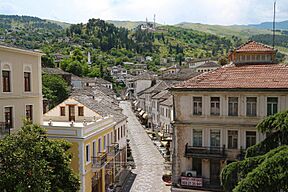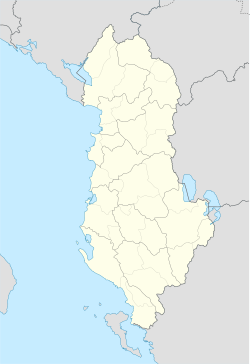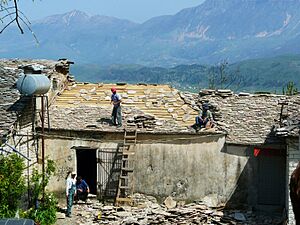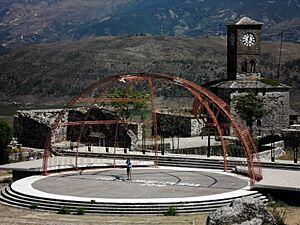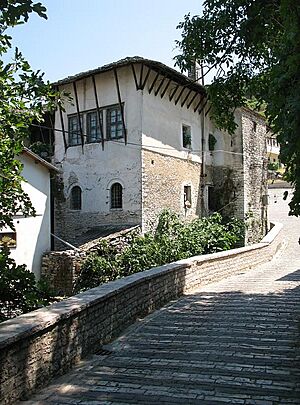Gjirokastër facts for kids
Quick facts for kids
Gjirokastër
Ergjëri
Αργυρόκαστρο Ljurocastru |
||
|---|---|---|
|
View over Gjirokastër
Clock tower
Ethnographic Museum
Old Bazaar
St. Sotir Church
Panorama of Gjirokastër
|
||
|
||
| Nickname(s):
City of Stone
|
||
| Country | ||
| County | Gjirokastër | |
| Area | ||
| • Municipality | 469.55 km2 (181.29 sq mi) | |
| Population
(2011)
|
||
| • Municipality | 28,673 | |
| • Municipality density | 61.0648/km2 (158.157/sq mi) | |
| • Municipal unit | 19,836 | |
| Demonym(s) | Albanian: Gjirokastrit (m), Gjirokastrite (f) | |
| Time zone | UTC+1 (CET) | |
| • Summer (DST) | UTC+2 (CEST) | |
| Postal Code |
6001–6003
|
|
| Area Code | 084 | |
| Website | ||
| Official name: The Historic Centres of Berat and Gjirokastra | ||
| Type: | Cultural | |
| Criteria: | iii, iv | |
| Designated: | 2005 | |
| Reference #: | 569 | |
| Region: | Gjirokastër County | |
| Europe: | 2005–present | |
Gjirokastër is a historic city in southern Albania. It is known for its unique Ottoman-era architecture. The city is located in a valley between the Gjerë mountains and the Drino river. It sits about 300 meters above sea level.
Gjirokastër's old town is a UNESCO World Heritage Site. This means it's a very important place that needs to be protected. The city is watched over by the impressive Gjirokastër Fortress. A big event called the Gjirokastër National Folk Festival happens there every five years.
This city is also famous for being the birthplace of two important Albanians. One was the former communist leader Enver Hoxha. The other was the well-known author Ismail Kadare.
The city's history goes back to 1336. It was first called Argyrókastro by the Greeks. It grew around the Gjirokastër Fortress. Over time, it was ruled by different groups, including the Byzantines and the Ottomans. During the Ottoman rule, many people in Gjirokastër became Muslim. It also became a center for the Bektashi faith.
In the early 1900s, Gjirokastër was part of the Balkan Wars. It was briefly taken by Greece but later became part of the new country of Albania in 1913. In recent years, the city has faced some challenges. It saw protests in 1997 due to economic problems. Today, Gjirokastër is home to Albanians, a Greek minority, and an Aromanian community. It's seen as an important center for the Greek minority in Albania.
Contents
- What's in a Name? The Meaning of Gjirokastër
- Gjirokastër Through Time: A Brief History
- Gjirokastër's Location and Weather
- Gjirokastër's Economy and Jobs
- Getting Around and Learning in Gjirokastër
- People and Beliefs in Gjirokastër
- Gjirokastër's Culture and Famous Places
- International Connections
- Famous People from Gjirokastër
- Images for kids
- See also
What's in a Name? The Meaning of Gjirokastër
The city's name first appeared in history as Argyrókastron in 1336. This name comes from two Greek words: argyrón, meaning "silver," and kástron, meaning "castle" or "fortress." So, the name means "silver castle."
Some people believe the city was named after a legendary princess named Argjiro. However, historians think this is just a folk tale. The princess likely lived much later, in the 1400s.
The Albanian name for the city, Gjirokastra, also comes from the Greek name. During the time of the Ottoman Empire, the city was known as Ergiri in Turkish.
Gjirokastër Through Time: A Brief History
Early Beginnings
Archaeologists have found old pottery in the Gjirokastër area. These items date back to the early Iron Age. The first people known to live here were the ancient Greek tribe called the Chaonians. They were part of the Epirote group. In ancient times, a city called Antigonia was located near modern Gjirokastër.
Medieval Times
Gjirokastër started to grow on the castle hill during the Middle Ages. The first fort was built around 5th or 6th century CE. It was expanded later, and people started living in the castle area by the 1200s and 1300s. During this time, it was known as "Silver City" or "Silver Castle."
The city was part of the Despotate of Epirus. It was first mentioned by its name, Argyrokastro, in 1336. The Albanian Zenebishi family later took control of Gjirokastër. It became their capital in 1417. However, the Ottomans took over the city in 1418. It then became an important center in the Ottoman Empire.
Ottoman Rule and Changes
An Ottoman traveler named Evliya Çelebi visited Gjirokastër in 1670. He described a busy city with many houses, mosques, churches, and shops. From the 1500s to the early 1800s, Gjirokastër changed from being mostly Christian to having a Muslim majority. This happened as people converted to Islam and new Muslim families moved in. The city also became a major center for the Bektashi faith, a type of Sufi Islam.
Modern Era: Wars and Changes
In 1811, Gjirokastër became part of a semi-independent region led by Ali Pasha. After his death, the city continued to be an important center. In the late 1800s, people in Gjirokastër were active in the Albanian National Awakening movement. This movement aimed for Albanian independence.
During the First Balkan War (1912–1913), Greece took control of Gjirokastër. But in 1913, international agreements gave the city to the newly independent Albania. This made some local Greek people unhappy. They wanted more local control or for the city to be part of Greece.
In 1939, Italy occupied Gjirokastër during World War II. Then, in 1940, the Greek army took the city. It was returned to Italian control in 1941, and later to German forces. Finally, in 1944, Gjirokastër came under Albanian control.
After the war, Albania became a communist country. Gjirokastër was made a "museum town" because it was the birthplace of the leader, Enver Hoxha. His childhood home was even turned into a museum.
After communism ended in 1991, Gjirokastër faced economic problems. There were protests in the city in 1997. Today, efforts are being made to restore the city's old houses and boost tourism.
Gjirokastër's Location and Weather
City Layout
The Gjirokastër municipality was formed in 2015. It includes the city of Gjirokastër and several surrounding areas. In 2011, the total population of the municipality was about 28,673 people. The city of Gjirokastër itself had about 19,836 residents.
Climate and Seasons
Gjirokastër has a hot-summer Mediterranean climate. This means it has hot, dry summers and mild, wet winters. It gets more rain than many other places with this climate type.
| Climate data for Gjirokastër | |||||||||||||
|---|---|---|---|---|---|---|---|---|---|---|---|---|---|
| Month | Jan | Feb | Mar | Apr | May | Jun | Jul | Aug | Sep | Oct | Nov | Dec | Year |
| Mean daily maximum °C (°F) | 9 (48) |
11 (52) |
13 (55) |
18 (64) |
23 (73) |
28 (82) |
32 (90) |
34 (93) |
27 (81) |
23 (73) |
15 (59) |
11 (52) |
20 (69) |
| Daily mean °C (°F) | 5 (41) |
6 (43) |
7 (45) |
12 (54) |
16 (61) |
20 (68) |
23 (73) |
24 (75) |
19 (66) |
14 (57) |
10 (50) |
6 (43) |
14 (56) |
| Mean daily minimum °C (°F) | 1 (34) |
1 (34) |
2 (36) |
6 (43) |
10 (50) |
13 (55) |
15 (59) |
15 (59) |
12 (54) |
8 (46) |
5 (41) |
2 (36) |
8 (46) |
| Average precipitation mm (inches) | 176 (6.9) |
170 (6.7) |
160 (6.3) |
82 (3.2) |
106 (4.2) |
63 (2.5) |
32 (1.3) |
25 (1.0) |
64 (2.5) |
112 (4.4) |
233 (9.2) |
305 (12.0) |
1,528 (60.2) |
| Average rainy days | 11 | 10 | 8 | 7 | 5 | 2 | 1 | 1 | 3 | 7 | 14 | 12 | 81 |
| Average relative humidity (%) | 71 | 69 | 68 | 69 | 70 | 62 | 57 | 57 | 64 | 67 | 75 | 73 | 67 |
| Mean monthly sunshine hours | 145.7 | 132.8 | 167.4 | 207 | 269.7 | 315 | 378.2 | 337.9 | 264 | 204.6 | 141 | 114.7 | 2,678 |
| Mean daily sunshine hours | 4.1 | 4.7 | 5.4 | 6.9 | 8.7 | 10.5 | 12.2 | 10.9 | 8.8 | 6.6 | 4.7 | 3.7 | 7.3 |
| Average ultraviolet index | 3 | 4 | 6 | 8 | 9 | 10 | 10 | 10 | 8 | 6 | 4 | 3 | 7 |
| Source 1: Weatherbase, Nomadseason(Precipitation-UV) | |||||||||||||
| Source 2: Weather2visit, Climate data | |||||||||||||
| Climate data for Gjirokastër elevation at 194 m or 636 ft from 1961-1990 | |||||||||||||
|---|---|---|---|---|---|---|---|---|---|---|---|---|---|
| Month | Jan | Feb | Mar | Apr | May | Jun | Jul | Aug | Sep | Oct | Nov | Dec | Year |
| Record high °C (°F) | 20.1 (68.2) |
23.3 (73.9) |
27.2 (81.0) |
28.7 (83.7) |
34.3 (93.7) |
38.9 (102.0) |
42.6 (108.7) |
39.5 (103.1) |
37.4 (99.3) |
32.5 (90.5) |
26.8 (80.2) |
21.5 (70.7) |
42.6 (108.7) |
| Mean daily maximum °C (°F) | 10.0 (50.0) |
11.9 (53.4) |
15.1 (59.2) |
19.1 (66.4) |
24.3 (75.7) |
28.6 (83.5) |
31.8 (89.2) |
31.8 (89.2) |
28.1 (82.6) |
22.0 (71.6) |
15.7 (60.3) |
11.1 (52.0) |
20.8 (69.4) |
| Mean daily minimum °C (°F) | 0.4 (32.7) |
1.5 (34.7) |
3.4 (38.1) |
6.7 (44.1) |
10.5 (50.9) |
13.7 (56.7) |
15.3 (59.5) |
15.2 (59.4) |
12.3 (54.1) |
8.4 (47.1) |
4.6 (40.3) |
1.6 (34.9) |
7.8 (46.0) |
| Record low °C (°F) | −10.1 (13.8) |
−8.0 (17.6) |
−16.6 (2.1) |
−1.8 (28.8) |
2.2 (36.0) |
5.8 (42.4) |
8.6 (47.5) |
8.3 (46.9) |
1.7 (35.1) |
−1.7 (28.9) |
−5.9 (21.4) |
−17.4 (0.7) |
−17.4 (0.7) |
| Average precipitation mm (inches) | — | — | — | — | — | — | — | — | — | — | — | — | 1,887.5 (74.31) |
| Average rainy days (≥ 1.0 mm) | — | — | — | — | — | — | — | — | — | — | — | — | 102.0 |
| Average snowy days | — | — | — | — | — | — | — | — | — | — | — | — | 4.0 |
| Average relative humidity (%) | — | — | — | — | — | — | — | — | — | — | — | — | 74.0 |
| Mean monthly sunshine hours | — | — | — | — | — | — | — | — | — | — | — | — | 2,456.8 |
| Source: National Oceanic and Atmospheric Administration (NOAA) | |||||||||||||
Gjirokastër's Economy and Jobs
Gjirokastër is mainly a trading center. It also has some industries that make food, leather, and textiles. A new market has been built in the city. It helps local farmers sell their produce. Southern Albania has the potential to grow organic products. This market might focus on organic farming in the future.
The city's Chamber of Commerce helps with trade, especially with nearby Greek areas. Greece has also helped Gjirokastër by building a hospital there.
Many old, traditional houses are being fixed up. This helps bring tourists back to the city. Tourism is becoming an important way for the local economy to earn money. However, some houses are still falling apart. This is because there isn't enough money for repairs. Also, local builders are not always involved in the restoration projects.
In 2010, the city faced economic problems. This was due to the economic crisis in Greece. Many Albanians who worked in Greece lost their jobs and returned home.
Getting Around and Learning in Gjirokastër
Transportation
Gjirokastër is connected by the SH4 Highway. This road links the city to Tepelenë in the north. It also connects to the Dropull region and the Greek border about 30 kilometers to the south.
Education and Schools
The first school in Gjirokastër was a Greek language school. It opened in 1663. Local merchants supported it. It was destroyed in 1821 but reopened in 1830. A madrasa, an Islamic school, also operated in the city from 1727 until 1967. That's when it closed during Albania's Cultural Revolution.
In 1861–1862, a Greek language school for girls was started. A local Greek helper, Christakis Zografos, paid for it. The first Albanian school in Gjirokastër opened in 1886. Today, the city has 14 Albanian schools. It also has two schools that teach in both Albanian and Greek.
The city is home to Eqrem Çabej University. It opened in 1968. Recently, fewer students have been enrolling. Some departments, like Physics and Mathematics, didn't even open in 2008–2009. In 2006, there were plans for a second university in Gjirokastër that would teach in Greek. However, this plan was stopped in 2010.
People and Beliefs in Gjirokastër
Population Overview
Gjirokastër grew quickly during the Ottoman era. It was a very important city in the region. In the late 1800s and early 1900s, most people in Gjirokastër spoke Albanian. There were also a few Greek-speaking families.
Today, Gjirokastër is the largest municipality in the Gjirokastër County. According to the 2011 census, the Gjirokastër Municipality had about 28,673 residents. The city of Gjirokastër itself had 19,836 residents.
The population is made up of different age groups. About 16.93% of the city's population is aged 0 to 14. About 70.27% are aged 15 to 64. And about 12.78% are 65 years or older.
Gjirokastër is home to an ethnic Greek community. Some sources say there were about 4,000 Greeks in 1989. However, Greek spokesmen have claimed the number is higher. Gjirokastër is considered a main center for the Greek community in Albania. There is also a Greek consulate in the city. Other smaller groups include Aromanians and Roma people.
It's important to know that the 2011 census results were affected by a boycott by some minorities. So, the numbers should be looked at carefully.
Religious Life
The Gjirokastër region was historically part of the Eastern Orthodox Church. The main church in the city, the "Transfiguration of the Saviour" Cathedral, was rebuilt in 1773. Today, the city has a diocese that is part of the Orthodox Autocephalous Church of Albania.
During the Ottoman period, Gjirokastër was a major center for the Muslim Sufi Bektashi Order. This religious group was very active here. In 1925, Albania became the world center of the Bektashi Order. Gjirokastër was one of its six main districts in Albania.
Historically, there were many Bektashi tekkes (religious buildings) and mosques in the city. However, most of them were destroyed or closed in 1967 during the communist government's Cultural Revolution. Only the Gjirokastër Mosque, built in 1757, has survived. The city still has a large Bektashi and Sunni Muslim population.
According to the 2011 census, about 42.3% of the local population is Muslim. About 5.3% are Bektashis, and 14.6% are Eastern Orthodox. About 2.8% are Roman Catholics. A large group, 35.2%, did not state any religion or are non-religious. Gjirokastër County had one of the highest percentages of atheists in Albania.
Gjirokastër's Culture and Famous Places
Local Traditions
In the 1600s, an Ottoman traveler described Gjirokastër as a very noisy city. He heard the sound of a vajtim, which is a traditional Albanian lament for the dead. He even called Gjirokastër the "city of wailing."
The famous Albanian writer Ismail Kadare wrote a novel called Chronicle in Stone. It tells the story of Gjirokastër during World War I and II. It also shares many details about the customs of the people there.
Another Albanian writer, Musine Kokalari, wrote a book called As my old mother tells me. It describes the daily lives and customs of women in Gjirokastër.
Gjirokastër is known for its polyphonic singing. This is a special type of singing where many voices sing different parts at the same time. The city hosts the Gjirokastër National Folklore Festival every five years. This festival started in 1968 and takes place at the Gjirokastër Fortress. The Greek language newspaper Laiko Vima is also published here. It was the only Greek-language newspaper allowed during the communist era.
City Landmarks
The city is built on a slope around its citadel, which is on a high plateau. While the city walls are very old, most of the buildings you see today are from the 1600s and 1700s.
Gjirokastër is nicknamed the "City of Stone." This is because many of its old houses have roofs covered with flat stones. These houses are often tall, stone buildings, sometimes up to five stories high. They have outside and inside staircases. This design might come from fortified country houses in southern Albania. The bottom floor usually has a water tank and a stable. The upper floors have guest rooms and family rooms with fireplaces.
Since Gjirokastër became a UNESCO World Heritage site, many houses have been restored. However, some still need repairs or are not being cared for properly.
The Gjirokastër Fortress stands over the town. It's open to visitors and has a military museum. The museum shows captured weapons and items from the time of the communist resistance. It also has a captured American plane. The fortress was expanded in the 1800s and 1900s. Today, it has five towers, a clock tower, a church, and water fountains. Part of the castle was used as a prison for political prisoners during the communist time.
Gjirokastër also has an old Ottoman bazaar. It was first built in the 1600s and rebuilt in the 1800s after a fire. More than 500 homes in Gjirokastër are protected as "cultural monuments." The Gjirokastër Mosque, built in 1757, is a main feature of the bazaar.
When the city was first suggested for the World Heritage list in 1988, experts noticed some modern buildings that didn't fit in. The historic center of Gjirokastër was finally added to the list in 2005.
Sports in Gjirokastër
Football (soccer) is very popular in Gjirokastër. The city has a club called Luftëtari Gjirokastër, which was started in 1929. The team has played in international games. They play their matches at Gjirokastër Stadium, which can hold up to 8,400 fans.
International Connections
Gjirokastër has "twin city" relationships with other cities around the world:
Famous People from Gjirokastër
- Arjan Bellaj, retired soccer player
- Bledar Devolli (born 1978), footballer
- Vangjel Dule, politician representing the Greek minority
- Bashkim Fino, former Prime Minister of Albania
- Christos Gikas, Greco-Roman wrestler
- Ardit Gjebrea (born 1963), Albanian singer and TV presenter
- Altin Haxhi, international soccer player
- Enver Hoxha (1908–1985), former leader of Albania
- Ismail Kadare (1936–2024), famous novelist and poet
- Xhanfize Keko movie director
- Saim Kokona (born 1934), cinematographer
- Albi Kondi (born 1989), football player
- Eqrem Libohova, former Prime Minister of Albania
- Omer Nishani, Head of State of Albania (1944–1953)
- Arlind Nora (born 1980), footballer
- Baba Rexheb, Bektashi Sufi religious leader
- Xhafer Sadik, Bektashi religious leader
- Çerçiz Topulli, 20th-century nationalist and fighter
- Haki Toska (1920–1994), politician
- Arjan Xhumba, retired soccer player
Images for kids
See also
 In Spanish: Gjirokastra para niños
In Spanish: Gjirokastra para niños


